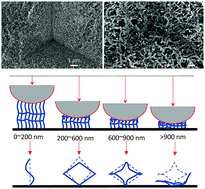Multi-scale progressive failure mechanism and mechanical properties of nanofibrous polyurea aerogels†
Abstract
The nonlinear mechanical properties, deformation and failure mechanisms of polyurea aerogels (PUAs) were investigated using a multi-scale approach that combines nanoindentation, analytical and computational modeling. The atomistic structure of primary particles of PUAs and their mechanical interactions were investigated with molecular dynamics simulations. From nanoindentation we identified four deformation and failure modes: free ligament buckling, cell ligament bending, stable cell collapsing, and ligament crush induced strain hardening. The corresponding structural evolution during indentation and strain hardening were analyzed and modeled. The material scaling properties were found to be dependent on both the relative density and the secondary particle size of PUAs. Using a porosity-dependent material constitutive model, a linear relationship was found between the strain hardening index and secondary particle size instead the conventional power-law relationship. Finally, the structural efficiency of PUAs with respect to the capability for energy absorption is evaluated as a function of structural parameters and base polymeric material properties.



 Please wait while we load your content...
Please wait while we load your content...
